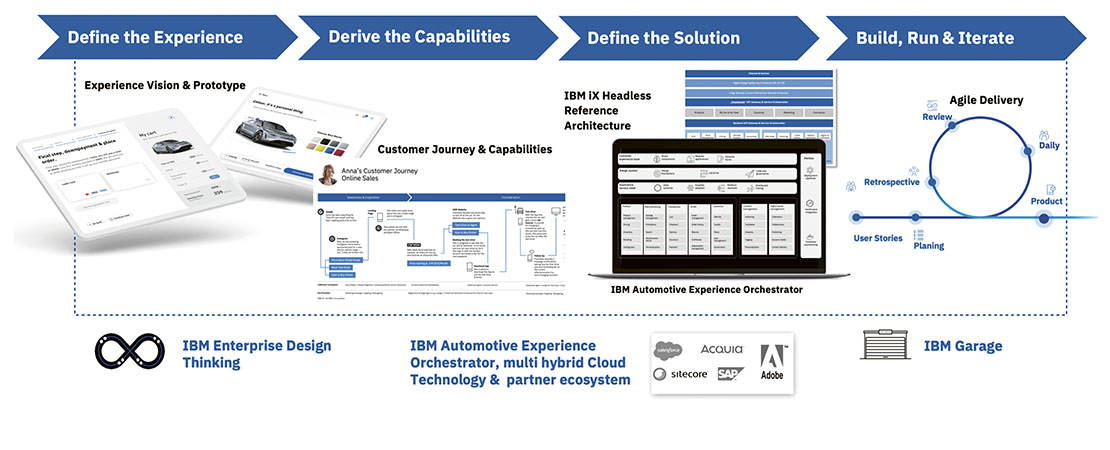
IBM Corporation
Creating the future of automotive commerce with the power of digital
Dirk Wollschläger
General Manager Global Automotive, Aerospace & Defense Industry, IBM Corporation
The customer journey of buying a car has not changed that much in the last years. So, it’s not a surprise that 61 percent of consumers in one major survey say, that their buying experience has not improved within the last years.¹ Although most companies have made first attempts to explore the potential of digital retail, it’s needless to say, that COVID-19 changed everything. Establishing a modern commerce experience is now a top priority. Working with many automotive companies, IBM has developed an approach to create digital automotive commerce solutions from customer experience to technology implementation.
selling vehicles.
To thrive, automotive brands must create a new perception of customer value that transcends the vehicle they’re selling. Success with digital commerce requires a fresh take on procedures, organizational structures, and IT architecture. Obviously, “COVID-19 has changed the market” and created the required momentum. The pandemic pushed auto marketers to grow bolder and embrace digital commerce. When the crisis hit, only digital leaders such as Tesla were able to sell their cars.
At IBM we are working within and outside the automotive industry and based on our experiences we have created a unique approach to design automotive commerce experiences.
Our approach (figure 1) focuses on the customer experience first, where the bar is set high, as customers are used to state-of-the-art digital experiences with Apple, Amazon and others.
IBM’s concept starts by envisioning the future sales experience from a consumer’s point of view, then using that vision to work backwards to inform process, organization and technological implementation. In sum: we call this an “experience-led” approach. The approach prevents a common pitfall to start from either the technology or the current organization leading to a solution that might fit the OEM, but not the customer demand.
Experience Design
Starting with the experience means to understand the customer and its future customer journey. To do so, we utilize proven assets such as Design Thinking. Digital prototypes are a good way to visualize experience, test customer acceptance and integrate feedback from the involved stakeholders.
To materialize the experience, design systems provide re-usable guidelines, UX/UI and code components for digital solutions. CTOs will need to consolidate experience across platforms like commerce, CRM, dealer management, content management, and experience platforms. These touchpoints must be harmonized to create a comprehensive, holistic, seamless and increasingly personalized digital experience.
A defined and aligned experience vision provides the basis and argumentative guideline to define the business, workflows and technology solutions.
Operational Model
Digital automotive commerce requires solid alignment across CMO, CXO, CTO and COO functions. The current organizational model will need to evolve to meet the demands of a seamless customer experience.
OEMs will need to integrate a wider ecosystem related to payment, credit checks and subscription management – just to skim the surface. Experiences that are established in other industries need to be seamless for the automotive customer.
To avoid a long strategy phase it’s important to understand the journey towards automotive commerce as agile. In the digital world, the only constant is change, so the operational model needs to be built for change.
To de-risk innovation in an uncertain environment, IBM has a proven operational model called IBM Garage. The agile framework brings together interdisciplinary teams across the organization in a guided schema. Within the three phases of Co-Create, Co-Execute and Co-Operate IBM teams work side-by-side with our clients and other partners to design, implement and operate a digital solution applying agile methodologies and years of learning.
Just recently a Forrester study validated the impact of the approach identifying a 102% RoI of Garage engagement with 10x more innovative ideas and a 2.5 to 3.2x faster per-project payback and 3x faster time to market.
Build and run the solution with a new paradigm: A headless approach
Answering the question, how future digital automotive commerce solutions should look like from a technology standpoint, OEMs need a flexible, open architecture to start small and scale fast to avoid technical lock-in. A point-to-point integration of internal systems and relevant external ecosystems can devolve into a nightmare of complexity and interdependency.
Traditionally, e-commerce implementations are either “content-led” or “commerce-led”. Commerce-led patterns allow transactional sites to ramp up quickly, often using templated storefronts. Alternatively, customized content-led sites can be painstakingly assembled in content management systems (CMS) and look stunning. But they can be costly to develop, implement and maintain. Both approaches lead to vendor lock-in and add complexity to system support requirements.
Instead of this traditional approach, we are seeing the emergence of headless patterns for automotive commerce. Headless commerce creates a sophisticated set of adapters between the front- and back-end layers, so neither depends on the other. This breaks potential commerce use cases into atomic components. These can be accessed or grouped in combinations to provide for virtually any number of use cases, using the same back-end. Adapters could call out to commerce, content, pricing, logistics, or third-party services – everything OEMs need to provide a commerce-focused experience. A headless approach even permits swapping among commerce back-ends, or using different packages in different markets, and this without noticeable variations.
Working with our clients to accelerate their automotive commerce journey IBM’s Experience Orchestrator for automotive provides a set of pre-built platform adapters and containerized frontend components. The platform adapters and a standardized data-model connect to the most relevant customer success platforms such as Adobe, Salesforce and Zuora. Frontend-wise there are templates for product descriptions, financing, my account components and many more and as they are part of a headless architecture, they are independent of specific CRM, CMS or Commerce system.
As the automotive industry is increasing the speed towards digital automotive commerce, we are looking forward supporting this journey with IBM’s proven framework for automotive commerce plus our services and technology expertise.


